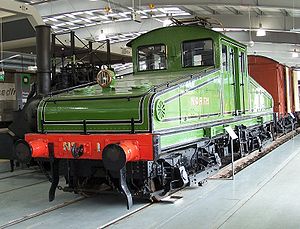British Rail Class ES1
| North Eastern Railway Class ES1 | |||||||||||||||||||||||||||||||
|---|---|---|---|---|---|---|---|---|---|---|---|---|---|---|---|---|---|---|---|---|---|---|---|---|---|---|---|---|---|---|---|

NER No.1, Locomotion museum, Shildon
|
|||||||||||||||||||||||||||||||
|
|||||||||||||||||||||||||||||||
|
|||||||||||||||||||||||||||||||
|
|||||||||||||||||||||||||||||||
|
|||||||||||||||||||||||||||||||
| Type and origin | |
|---|---|
| Power type | Electric |
| Builder | British Thomson-Houston, with mechanical parts sub-contracted to Brush, for North Eastern Railway |
| Build date | 1903-1904 (contract signed with builders on 15 December 1902) |
| Total produced | 2 |
| Specifications | |
|---|---|
| Configuration: |
|
| • Whyte | Bo-Bo |
| • AAR | B-B |
| • UIC | Bo+Bo |
| Gauge | 4 ft 8 1⁄2 in (1,435 mm) standard gauge |
| Wheel diameter | 3 ft 0 in (0.914 m) |
| Wheelbase | 27 ft 0 in (8.230 m) |
| Length | 37 ft 11 in (11.557 m) |
| Height | with pantograph lowered 12 ft 11 in (3.937 m); raised 15 ft 9 in (4.801 m) |
| Loco weight | 56 long tons (57 tonnes; 63 short tons) |
| Electric system(s) | 600–630 V DC, Third rail or catenary |
| Current source | Contact shoe or pantograph |
| Traction motors | British Thomson-Houston, 4 off |
| Train heating | None |
| Performance figures | |
|---|---|
| Maximum speed | 27 mph (43 km/h) |
| Power output | 640 bhp (477 kW) |
| Tractive effort | 25,000 lbf (111.2 kN) 335 t (330 long tons; 369 short tons) @ 14 mph (23 km/h) |
| Career | |
|---|---|
| Operators |
North Eastern Railway London and North Eastern Railway British Railways |
| Numbers | NER: 1–2 LNER 1–2, later 6480–6481 BR: 26500–26501 |
| Axle load class | Route availability 2 |
| First run | 1905 |
| Retired | 1964 |
| Disposition | No.1 preserved, No.2 scrapped in 1966 |
British Rail Class ES1 (Electric Shunting 1)is a class of two electric locomotives commissioned by the North Eastern Railway in 1902. They were of steeplecab design.
Both locomotives passed to the London and North Eastern Railway in 1923 and then to British Railways in 1948, but both were withdrawn before TOPS.
The North Eastern Railway was an enthusiastic and relatively early adopter of electric traction for railways. As part of a 1902 scheme to electrify the suburban railway networks in the Tyneside area, the NER's Chief Mechanical Engineer, Wilson Worsdell, also wished to electrify a 3⁄4-mile (1.2 km), horseshoe-shaped freight line that went from Trafalgar Yard in Manors to Newcastle Quayside Yard. Passing through three tunnels, this line had gradients as steep as 1:27 (3.70 %) and a number of sharp curves: it presented a formidable challenge for steam traction. Working conditions inside the tunnels were atrocious because the locomotives had to work exceptionally hard to manage the gradients which meant they produced vast quantities of choking fumes that could not disperse from the tunnels; the sparks they produced were a constant fire risk to the flammable packing materials in the yards. Electrification was the obvious answer.
The specification for new electric locomotives demanded that they be able to start a train of 150 tons on the steepest gradient, while on the level they were expected to be able to haul 300 long tons (305 t; 336 short tons) at 14 mph (23 km/h). The end-to-end journey on the branch was to be completed in 4.5 minutes.
In 1900 General Electric (GE) and Thomson-Houston designed and built a locomotive of the steeplecab type for the Milan-Varese railway in Italy, electrified at 650 V DC using the third rail system. That railway opened in 1901, and the locomotive design proved successful. The North Eastern Railway's ES1s were derived from that American design, although they were designed from the start for both third rail and overhead operation: the Newcastle Quay branch used both systems—third rail in the tunnels, and overhead lines on the rest of the line.
...
Wikipedia
